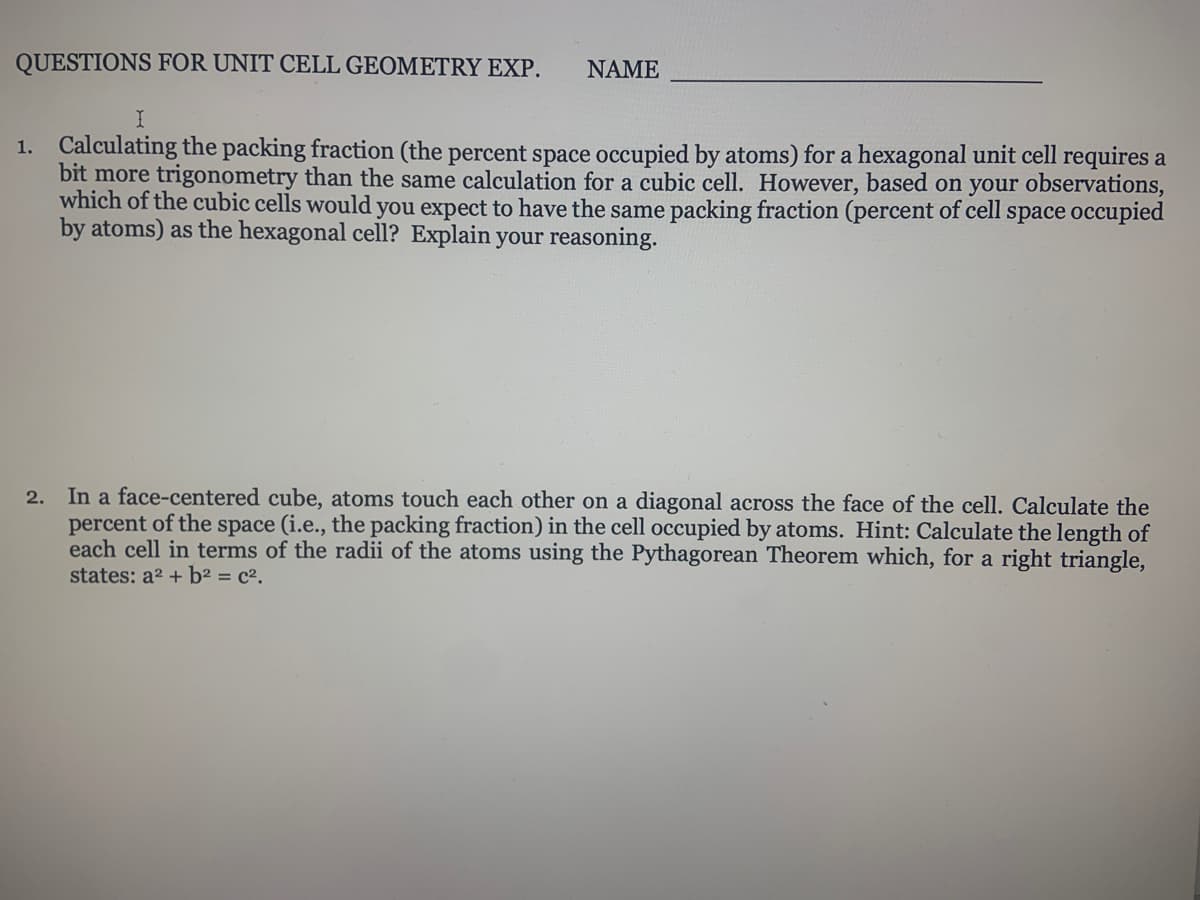QUESTIONS FOR UNIT CELL GEOMETRY EXP. NAME 1. Calculating the packing fraction (the percent space occupied by atoms) for a hexagonal unit cell requires a bit more trigonometry than the same calculation for a cubic cell. However, based on your observations, which of the cubic cells would you expect to have the same packing fraction (percent of cell space occupied by atoms) as the hexagonal cell? Explain your reasoning. In a face-centered cube, atoms touch each other on a diagonal across the face of the cell. Calculate the percent of the space (i.e., the packing fraction) in the cell occupied by atoms. Hint: Calculate the length of each cell in terms of the radii of the atoms using the Pythagorean Theorem which, for a right triangle, states: a2 + b2 = c². 2.
QUESTIONS FOR UNIT CELL GEOMETRY EXP. NAME 1. Calculating the packing fraction (the percent space occupied by atoms) for a hexagonal unit cell requires a bit more trigonometry than the same calculation for a cubic cell. However, based on your observations, which of the cubic cells would you expect to have the same packing fraction (percent of cell space occupied by atoms) as the hexagonal cell? Explain your reasoning. In a face-centered cube, atoms touch each other on a diagonal across the face of the cell. Calculate the percent of the space (i.e., the packing fraction) in the cell occupied by atoms. Hint: Calculate the length of each cell in terms of the radii of the atoms using the Pythagorean Theorem which, for a right triangle, states: a2 + b2 = c². 2.
Chemistry & Chemical Reactivity
10th Edition
ISBN:9781337399074
Author:John C. Kotz, Paul M. Treichel, John Townsend, David Treichel
Publisher:John C. Kotz, Paul M. Treichel, John Townsend, David Treichel
Chapter12: The Solid State
Section: Chapter Questions
Problem 50GQ: Consider the three types of cubic units cells. (a) Assuming that the spherical atoms or ions in a...
Related questions
Question
Help questions 1&2

Transcribed Image Text:QUESTIONS FOR UNIT CELL GEOMETRY EXP.
NAME
1. Calculating the packing fraction (the percent space occupied by atoms) for a hexagonal unit cell requires a
bit more trigonometry than the same calculation for a cubic cell. However, based on your observations,
which of the cubic cells would you expect to have the same packing fraction (percent of cell space occupied
by atoms) as the hexagonal cell? Explain your reasoning.
In a face-centered cube, atoms touch each other on a diagonal across the face of the cell. Calculate the
percent of the space (i.e., the packing fraction) in the cell occupied by atoms. Hint: Calculate the length of
each cell in terms of the radii of the atoms using the Pythagorean Theorem which, for a right triangle,
states: a2 + b² = c².
2.
Expert Solution
This question has been solved!
Explore an expertly crafted, step-by-step solution for a thorough understanding of key concepts.
Step by step
Solved in 2 steps with 2 images

Knowledge Booster
Learn more about
Need a deep-dive on the concept behind this application? Look no further. Learn more about this topic, chemistry and related others by exploring similar questions and additional content below.Recommended textbooks for you

Chemistry & Chemical Reactivity
Chemistry
ISBN:
9781337399074
Author:
John C. Kotz, Paul M. Treichel, John Townsend, David Treichel
Publisher:
Cengage Learning

Chemistry & Chemical Reactivity
Chemistry
ISBN:
9781133949640
Author:
John C. Kotz, Paul M. Treichel, John Townsend, David Treichel
Publisher:
Cengage Learning

General Chemistry - Standalone book (MindTap Cour…
Chemistry
ISBN:
9781305580343
Author:
Steven D. Gammon, Ebbing, Darrell Ebbing, Steven D., Darrell; Gammon, Darrell Ebbing; Steven D. Gammon, Darrell D.; Gammon, Ebbing; Steven D. Gammon; Darrell
Publisher:
Cengage Learning

Chemistry & Chemical Reactivity
Chemistry
ISBN:
9781337399074
Author:
John C. Kotz, Paul M. Treichel, John Townsend, David Treichel
Publisher:
Cengage Learning

Chemistry & Chemical Reactivity
Chemistry
ISBN:
9781133949640
Author:
John C. Kotz, Paul M. Treichel, John Townsend, David Treichel
Publisher:
Cengage Learning

General Chemistry - Standalone book (MindTap Cour…
Chemistry
ISBN:
9781305580343
Author:
Steven D. Gammon, Ebbing, Darrell Ebbing, Steven D., Darrell; Gammon, Darrell Ebbing; Steven D. Gammon, Darrell D.; Gammon, Ebbing; Steven D. Gammon; Darrell
Publisher:
Cengage Learning

Chemistry
Chemistry
ISBN:
9781305957404
Author:
Steven S. Zumdahl, Susan A. Zumdahl, Donald J. DeCoste
Publisher:
Cengage Learning


Chemistry: An Atoms First Approach
Chemistry
ISBN:
9781305079243
Author:
Steven S. Zumdahl, Susan A. Zumdahl
Publisher:
Cengage Learning